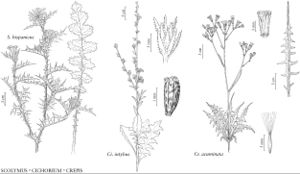Cichorium intybus
Sp. Pl. 2: 813. 1753.
Perennials (sometimes flowering first year). Leaves: blades of basal 5–35+ × 1–8(–12+) cm; cauline similar, smaller, narrower, distal mostly linear. Peduncles mostly 0–2 mm, some narrowly clavate, 12–45(–85+) mm. Phyllaries: outer 5–6 lance-ovate to lanceolate, 4–7 mm, basally cartilaginous, distally herbaceous, inner 8+ lance-linear to linear, 6–12 mm, herbaceous, all usually with some gland-tipped hairs 0.5–0.8 mm on margins near bases or on abaxial faces toward tips. Cypselae 2–3 mm; pappi 0.01–0.2 mm. 2n = 18.
Phenology: Flowering Apr–Jul.
Habitat: Disturbed sites
Elevation: 0–1500 m
Distribution

Introduced; St. Pierre and Miquelon, Alta., B.C., Man., N.B., Nfld. and Labr., N.S., Ont., P.E.I., Que., Sask., Ark., Calif., Conn., Ill., Ind., Iowa, Kans., Maine, Mass., Mich., Mo., Nev., N.H., N.Y., N.C., Pa., R.I., Tex., Utah, Vt., Europe, Asia, introduced also in Africa, South America.
Discussion
Leaves of Cichorium intybus are sometimes used as salad greens; the roasted roots are sometimes ground and used as an addition to (or adulterant of) coffee.
Selected References
None.
